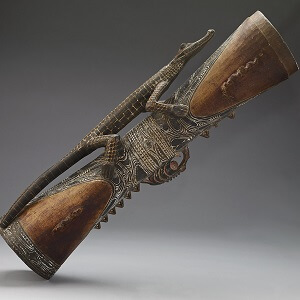Kundu
 The kundu is a single-head hourglass drum of Papua New Guinea. “Kundu” is a generic name for such drums, but each of the hundreds of tribal groups on the island of New Guinea and many of its surrounding islands has a local name for this drum type. Based on morphological and decorative clues, the kundu pictured and described here very likely originated amongst the Iatmul people of the Middle Sepik River region of Papua New Guinea. A number of similar Iatmul drums can be found in museum collections around the world, and some of these are named kwangu (or kangu or kwang-gu), which would appear to be the term for such kundu drums in the language of the Iatmul.
The kundu is a single-head hourglass drum of Papua New Guinea. “Kundu” is a generic name for such drums, but each of the hundreds of tribal groups on the island of New Guinea and many of its surrounding islands has a local name for this drum type. Based on morphological and decorative clues, the kundu pictured and described here very likely originated amongst the Iatmul people of the Middle Sepik River region of Papua New Guinea. A number of similar Iatmul drums can be found in museum collections around the world, and some of these are named kwangu (or kangu or kwang-gu), which would appear to be the term for such kundu drums in the language of the Iatmul.
The shell of this kundu is carved from a solid block of hardwood using metal tools and fire to produce its tubular hourglass form and thin walls. This form includes an integral handle. Further reductive carving with metal tools is used to produce the symbolically-rich surface decoration. One end of the drum is left uncovered, while the other is covered with a head made of a lizard skin that is glued with tree gum or other natural substances to a 1-inch wide exterior band around the rim of the opening. Small black pellets of beeswax, used for fine tuning the sound quality of the drum, are attached in a circular pattern around the center of the head. There is no indication of this drum having ever been painted; several of the kwangu in museum collections are decoratively painted.